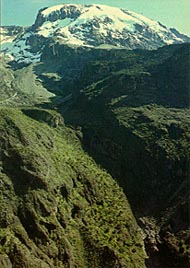| General information
Many travellers are attracted to the highest point in Africa - Uhuru Peak on
Kibo - which can be reached by several easy walking or scrambling routes.
The two main summits of Kilimanjaro: craggy Mawenzi, 5149m, and 'flat-topped',
Kibo, 5896m are separated by The Saddle, a 5km wide, high-altitude,
semi-desert. From the summit glaciers, screes, cliffs, afro-alpine moorland
then forests lead down to the cultivated foothills below. The main routes to Kibo are:
The Marangu Route offers walking on gentle forest and moorland paths up to 4700m.
Above, scree leads to Gillman's Point on the often snowy crater rim which is
followed to Uhuru Peak. Accommodation is in huts.
The Machame and Umbwe Routes are tougher. Steep forest paths, easy scrambling and airy ridges
lead to the final screes and hence the crater. Nights are spent in
tents. The Mweka Route is generally used to descend after either of the
last two routes.
The Shira, Nanjara and Rongai (Oloitokitok) Routes are more remote but can be organised
by us, the Rongai Route is popular with those looking for a less demending
route but away from the busy Marangu Route. The remote Lemosho Glades Route , is particularly beautiful and goes through one of the few areas on
Kilimanjaro that is rich in game.
For detailed help see: choosing your route.
|  Kilimanjaro from Barranco Kilimanjaro may be attempted by strong mountain walkers, however it is easy to
gain height too quickly and altitude related illness or considerable discomfort
is experienced by many who try to go up too fast.
Medical Aspects of high-altitude mountaineering |





















